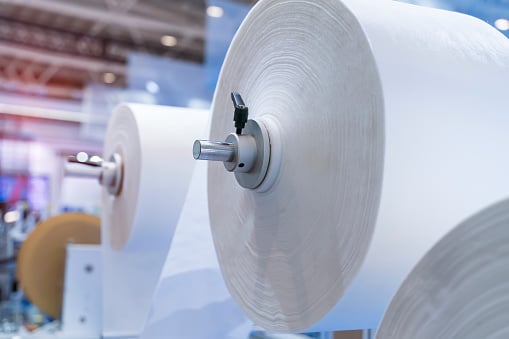Directional or random fibers make up non woven cloth, often known as non woven material. It is termed fabric because it resembles cloth in appearance and in some ways.
Advantages of Non-woven fabric:
1. Lightweight: The primary raw material used in production is polypropylene resin. Only three-fifths of cotton has a specific gravity of 0.9. It feels lovely and is fluffy.
2. Soft: It is surrounded by a thin, heated melt and is constructed of fine fiber (2–3D). The end product has a soft, cozy feel.
3. Polypropylene slices are non-absorbent and have no water content, making them waterproof and breathable. The finished item is 100% fiber, porous, has good air permeability, is easy to dry and clean, and has good water resistance.
4. Non-woven synthetic fabric is non-toxic and non-irritating because it is made from food-grade materials and does not include any additional chemical components. Stable, non-toxic, odorless, and skin-irritating are all characteristics of its performance.
5. Chemical passivation materials that can separate bacteria and insects in liquids include polypropylene, which is an antibacterial and antichemical reagent that does not contain insects. Corrosion strength won't have an impact on antibacterial, alkali corrosion, or finished goods.
6. Antibiotic. The item can be removed with water, won't grow mold, and will keep insects and bacteria separate from the liquid without growing mold.
7. It has good physical characteristics because it is made entirely of polypropylene. The product's strength surpasses that of typical staple fiber products. The strength is non-directional and comparable to both longitudinal and transverse strengths.
8. The majority of non-woven fabrics are made from polypropylene, which is environmentally friendly, whereas plastic bags are made from polyethene. The two compounds are not chemically same despite having similar names. Polyethene's chemical molecular structure is remarkably stable and difficult to break down. Plastic bags therefore take 300 years to decompose. The chemical structure of polypropylene is weak, making it simple to break the molecular chain and easily degradable. Additionally, non-woven shopping bags can degrade entirely in 90 days and enter the next environmental cycle in a non-toxic state. Additionally, non-woven shopping bags may be recycled up to ten times, and their post-treatment environmental impact is just 10% that of plastic bags.
Non-woven material features that safeguard the environment
1. Garden tree transplanting and artificial planting. Before the fake planting, large trees and small seedlings can be placed in the pit first, followed by the false planting, and then spread out on the fertile soil. This technique has a high chance of survival and is good for fertilizer and water conservation.
2. In the winter, cover the seedlings in the greenhouse and the open fields with the floating surface. It can both increase temperature and stop wind from blowing. The non-woven cloth can either be compacted with the soil in the seedbed or constructed into a little arch shelter and kept warm by bricks or soil compacting all around it. Vegetables, flowers, and other items that are covered require more sunlight; cover them in the morning and evening. The vegetables covered can be marketed 5-7 days earlier and the yield can be enhanced by approximately 15%. The surface covering can raise the temperature by 10 cm from the surface by about 2°C and the ground temperature by 1-2°C.
3. Use it as a roof. A non-woven synthetic cloth and plastic greenhouse film with a 15-20 cm gap are used in the greenhouse. When a thermal insulation layer is formed in this way, the shed's temperature can rise by 3 to 5 degrees Celsius. The layer is closed at night and must be sealed during the day.
4. In addition, a layer of non-woven fabric can be covered on the small arch canopy, and the temperature can also be increased by 5-8°C after the plastic film is covered. By using this method, you can cover the small arch shed (80-100g / 280cm) instead of a straw curtain for insulation and save 20% of the cost.
5. To prevent sun damage. The whole seedling can be successfully improved with non-woven textiles directly covered in the bed, morning cover, and evening cover. In the summer, one can directly cover seedlings of vegetables, flowers, and other plants.
6. Directly covering crops that are susceptible to freezing damage, such as tea leaves and flowers, with non-woven cloth before the cold wave hits can significantly reduce the loss of freezing damage.
Different applications for various non-woven fabric types
1. Operating clothes, protective clothing, face masks, diapers, civil dishcloths, cleaning cloths, wet face towels, magic towels, soft towel rolls, beauty products, sanitary towels, sanitary pads, disposable sanitary cloths, and other items can all be made from non-woven medical and sanitary fabrics.
2. You can use this non-woven material for wall coverings, tablecloths, bed sheets, bedspreads, and other household decorations.
3. The non-woven synthetic fabric can be used for various synthetic leather bottom cloth, adhesive lining, flocculation, set cotton, and other purposes.
4. Filter materials, insulating materials, cement bags, geotextile, covering cloth, etc. can all be made from non-woven industrial fabrics.
5. Agricultural non-woven fabric can be used for insulation curtains, crop protection cloth, and seedling cultivation cloth.
6. Other options include tea bags, linoleum, cigarette filters, thermal insulation materials, and space cotton.
It is not difficult to see that non-woven fabrics are not all created equal due to their various uses, but different industries use non-woven synthetic fabrics in different ways as well, such as spunlace nonwoven, spun-bonded non-woven, hot-rolled non-woven, melt-blown non-woven fabric, needle-punched non-woven fabric, etc. As a result, people must choose non-woven fabrics that are appropriate for their own equipment when making their own decisions.
For the best services, get in touch with GREENCARE

